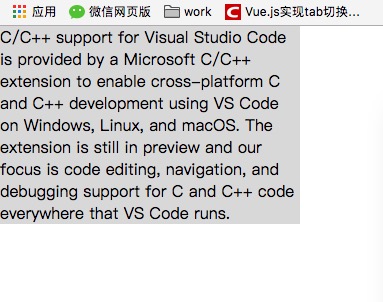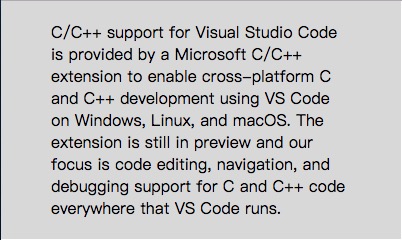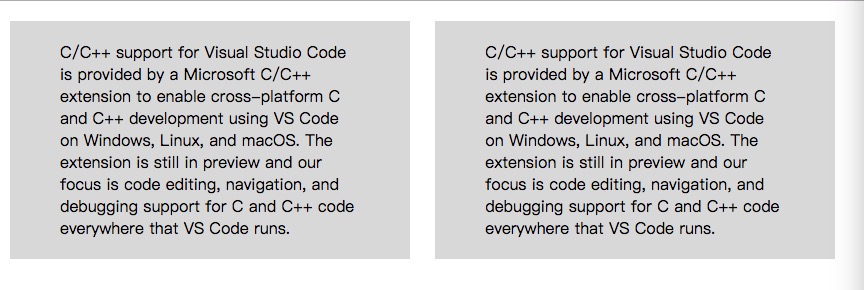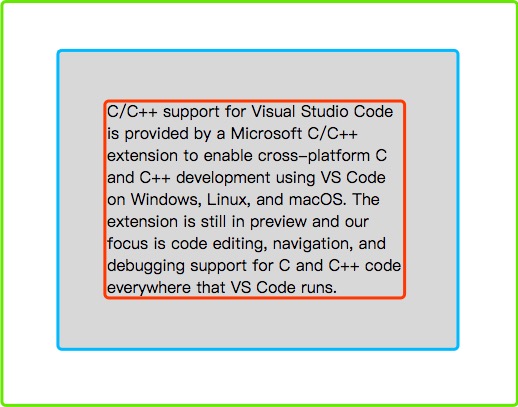一个div是如何被撑起来的? width(自身宽度)+ padding(内边距)+ margin(外边距)

首先是自身宽度,我们可以设置宽度,那么div中的元素如果没有设置样式会从这个div的左上角开始排列。
我们来通过一个实例:
<!DOCTYPE html> <html> <head> <meta charset="utf-8"> <title>example</title> <style> body{ margin:0; } .main{ background:#ddd; width:300px; } </style> </head> <body> <div class="main"> C/C++ support for Visual Studio Code is provided by a Microsoft C/C++ extension to enable cross-platform C and C++ development using VS Code on Windows, Linux, and macOS. The extension is still in preview and our focus is code editing, navigation, and debugging support for C and C++ code everywhere that VS Code runs. </div> </body> </html>
这时我们只给了宽度,看一下效果图

我们会发现如果只有自身的宽度,这个文本的排版会显得很拥挤 ,那么如果将文本从内部撑开呢?我们可以为这个div加一点内边距
.main{ background:#ddd; width:300px; padding:20px 50px; }
我们加了上下20px,左右50px的内边距,然后效果如下:

这样就舒服多了,我们也可以看出来内边距的效果是显示在div内部的,内边距的地方也会有背景色。
那我们要怎么把两个紧挨的div分开,让他们有一定的间隔呢,这就需要外边距了
在上面的基础上,我们再加上一行代码
<!DOCTYPE html> <html> <head> <meta charset="utf-8"> <title>example</title> <style> body{ margin:0; } .main{ display: inline-block; /*div块状元素,此处将它设置为行内块元素*/ background:#ddd; width:300px; padding:20px 50px; margin:20px 10px; } </style> </head> <body> <div class="main"> C/C++ support for Visual Studio Code is provided by a Microsoft C/C++ extension to enable cross-platform C and C++ development using VS Code on Windows, Linux, and macOS. The extension is still in preview and our focus is code editing, navigation, and debugging support for C and C++ code everywhere that VS Code runs. </div> <div class="main"> C/C++ support for Visual Studio Code is provided by a Microsoft C/C++ extension to enable cross-platform C and C++ development using VS Code on Windows, Linux, and macOS. The extension is still in preview and our focus is code editing, navigation, and debugging support for C and C++ code everywhere that VS Code runs. </div> </body> </html>
然后我们看效果,两个相同的div被外边距撑开了,我们也能看到外边距是独立在元素外部的,没有背景色。

总结一下,内外边距的的作用:
内边距——向内占宽度
外边距——向外占宽度

补充:margin,padding的书写方法
padding:20px; margin:20px;
上下左右都为20px
padding:20px 10px; margin:20px 10px;
上下为20px,左右为10px
padding:20px 10px 30px; margin:20px 10px 30px;
上为20px,左右为10px,下为30px
padding:20px 10px 30px 40px; margin:20px 10px 30px 40px;
上20px,右10px,下30px,左40px
ENDING ~ ~